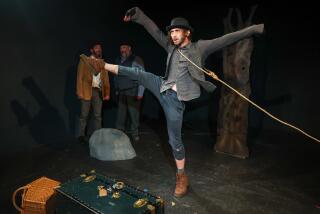OC HIGH: STUDENT NEWS AND VIEWS : Before the Curtain : Behind the Scenes of the School Play: Confidence-Building and Camaraderie
Sally Field did it. Brad Pitt did it. And many high-schoolers across the nation still do it. It’s not a trend, but rather a tradition: the high school play.
From the first casting call to opening night, high school plays are rich not only in tradition but emotion. The Capistrano Valley High School production of “Lost in Yonkers” was no exception. Here is how it took shape:
58 days before curtain
It’s an open casting call for four male and three female roles in “Lost in Yonkers,” the 1991 Pulitzer Prize-winning play by Neil Simon. Just place your John Hancock on the audition sign-up sheet taped to the drama room door, and you have got yourself a shot at becoming a member of the cast.
Now that the easy part is over, it’s time to audition . . . with a New York accent.
Each student picks up a script and a questionnaire, on which they divulge (or plead for) their “Lost in Yonkers” dream role to director Joe Slevcove, a drama and English teacher at Capistrano Valley High.
The play is about two guys who always used to joke about how scary their grandma was. That was before they had to move in with her for a year--and now the joke’s on them.
Students review the script silently or rehearse it with a friend and then are called to the front of the classroom in groups of five.
Slevcove assigns each student a role, and the teen-agers, reading the script, create a rough interpretation of a scene. The students then switch roles.
All the while, Slevcove sits at his desk making quick notes of every individual’s ability in each role. All the while, each teen-ager yearns to get his hands on those notes.
56 days before curtain
The callback list is posted on the drama room door, noting the students that the director wishes to see audition a second time. No need for despair. If your name doesn’t appear on the sheet, it doesn’t necessarily mean you have been eliminated. It could also mean you have already been chosen for a role.
54 days before curtain
The suspense is brewing! Students crowd around the drama room in hopes of sneaking a peek at the final cast list. Because the cast will be so small for this play, director Slevcove has decided to double-cast Bella and Grandma; two actresses will play each role, alternating nights when the play hits the stage.
Nine students--six seniors, two juniors and a freshman--walk away as elated cast members. The rest must console themselves with the knowledge that they tried.
20 days before curtain
Winter vacation is over, and the cast rehearses after school, three hours a day, five days a week.
The first two days of rehearsal, the cast performs in the drama room with lights dimmed, six stage lights spotlighting the center of the room. Chairs and desks act as props, and the actors read from scripts.
Soon, however, the pressure is on. Slevcove is requiring his actors to be “off book” within three days--that means to have all your lines memorized.
It only takes Mai-Lei Young, an 18-year-old senior who plays Bella, eight hours to learn 81 pages of lines. She and many of her co-stars record their lines on an audiocassette and play them over and over, to get them ingrained in their brains.
“My mom also helps me with the lines that I need help with, which is only about two-thirds of them,” Young jokes.
The following days of rehearsals are more frustrating. The actors forget their lines and have to break the mood of the scene by yelling “Line!” This is where assistant director Grace Nassar, a 16-year-old junior, comes in. She follows the script throughout the rehearsal and gives the actors line cues when they are at a loss for words.
It’s not all work and no play. There is plenty of comic relief. Jokes and horseplay are abundant, and laughter often peals through the air during the kissing scene.
Throughout rehearsals, director Slevcove breaks in and offers suggestions to improve the play and takes notes on each performance. The last 15 minutes of each practice, Slevcove reads his notes to the cast, and they prepare to make improvements for tomorrow’s rehearsal.
11 days before curtain
Crack out your grubby clothes and whip out your favorite paint brush because it’s Technical Day! Today’s mission: Transform the high school’s multipurpose room into a New York apartment in the 1940s.
The main set is constructed by a stage-craft and construction class on the high school campus. Nevertheless, plenty of dirty work is left to the cast. Boards are nailed to the floor, walls are painted and molding is attached to the walls.
Four days before curtain
Dress rehearsals, and the opportunity for the cast to become accustomed to costumes, props and the stage. Thrift shops, the drama closet and, of course, Mom and Dad’s closet are great suppliers of costumes. The place for props, however, is the drama storage room--the final resting place for theatrical memorabilia.
12 hours before curtain
It is 8 a.m. on the day “Lost in Yonkers” will make its Capistrano Valley High School debut, and the butterflies in everyone’s stomachs seem to know it.
“I’ve never been so scared before in my life. I just keep praying every second and taking three deep breaths,” said 17-year-old senior Lauren Duarte, who portrays Bella.
“My mom is taking me to Diedrich’s to get a triple-iced mocha. Then I’m going to have my Sleepy Time chamomile tea and review my lines,” added Young, whose pre-performance ritual is the same for every play.
2 1/2 hours to curtain
The dramatists arrive at school ready and raring to give a charged performance. Chairs are assembled for the audience, and curtains are hung. Two microphones are suspended from the ceiling above the stage, and two floor microphones are laid at the front of the stage.
Stage lights are positioned, tested and “gelled” to focus attention of specific areas of the stage. Gelling simply means to put a piece of yellow plastic in front of the light.
“White light isn’t really natural looking. The yellow makes it look more natural and less harsh,” explained lighting director Rob VanArsdale, a 17-year-old junior who learned his trade from former high school students.
One hour, 45 minutes to curtain
The heat is on, literally, as the cast members squeeze their way up to a mirror surrounded by high-wattage light bulbs in the makeup room. Eye-lining pencils, lipsticks and hair gels are strewn across the room, and everything seems to have a fine layer of facial powder covering it.
The actors work to get their hair into that 1940s look. “Last night, my hair was like a shell. I just touched it and my whole head moved,” recalled Steve Baker, an 18-year-old senior who plays a lead role.
Each cast member is required to apply a facial base and powder as well as eyeliner. For the males, this can be a problem. Not to fear! The female co-stars lend a helping hand, often laughing at the boys’ cosmetic ignorance.
As the minutes tick by, things get jittery. “Nobody’s got toothpaste, do they?” yells senior Matt Roberts, 18, while senior Chris Grisanti, 18, shouts, “Does anybody have a finer makeup brush? I’m dying!” And freshman Ryan Pass-
water, 14, pleads, “I need Kleenex! My shoes are too big!”
45 minutes to curtain
Warm-up. Riled and ready, the cast flies into the drama classroom. The session begins with relaxation, each person lying on his back, breathing deeply.
“As you exhale, enjoy it. Just let go of the tension,” encourages director Slevcove, who warms up with his actors.
Each actor stands when ready and stretches. The back is rolled out, and the arms, legs and jaw are shaken out in a process straight out of “Poltergeist.” The actors then pace the room, walking and making gestures as their character would.
An important part of the warm-up process is conjuring the chest voice. The chest voice is the loud and far-projecting voice. To get into this state of speaking, the group starts off by relaxing facial muscles. They make faces, stick out their tongues and attempt to touch them to noses and chins. Next, they count in unison, each time counting higher in the same breath and preparing themselves for longer lines.
Of course, being able to say long lines does not matter if they can’t be understood. Enunciation is key. Ten minutes of warm-up is allocated for annunciation exercises or, more accurately, tongue-twisting.
The dramatists say the nonsensical “papapabababa-tatatadadada-kakakagagaga” forward and backward, with increasing speed. If the tongue is not thoroughly knotted, they continue with the traditional tongue-twister of CVHS drama: “Theopolus Thick thong while sifting a sieve full of unsifted thistles.” Get the picture?
Eight minutes to curtain
It’s time for “shake the love.” The cast stands in a circle, holding hands. Everyone shakes his arms, throws them up in the air and cheers.
Three minutes to curtain
Eyes are tightly closed as Slevcove gives the final pep talk. “It has been a blast. This is one of my favorite scripts, and you’ve done it justice. Thank you. Go out there tonight and celebrate the story. It is powerful! Let it break your heart.”
One minute to curtain
Lights dim.
The moment of truth.
Postscript
“Lost in Yonkers” played to a full house on Feb. 8, 9, 10, 11, 13 and 15. The tradition lives on.
More to Read
The biggest entertainment stories
Get our big stories about Hollywood, film, television, music, arts, culture and more right in your inbox as soon as they publish.
You may occasionally receive promotional content from the Los Angeles Times.










